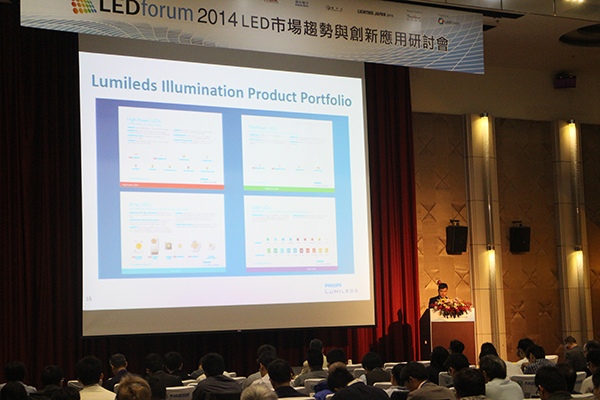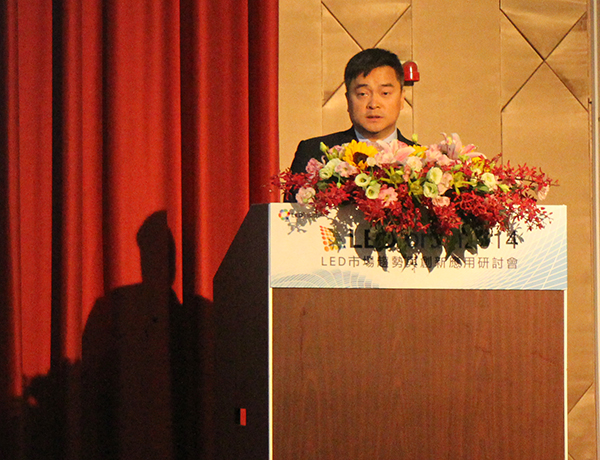LED prices will continue to fall over the next few years, but this is a phase that will probably pass, said Sean Zhou, Regional Marketing Director, Asia, Philips Lumileds at LEDforum 2014, which took place Friday in Taipei, Taiwan. Manufacturers aiming to improve profits will be increasingly turning towards cost-effective technologies, such as flip-chip LEDs.
 |
|
Audiences listen attentively to Sean Zhou, Regional Marketing Director, Asia, Philips Lumileds (far right) delivers his speech at LEDforum 2014 in Taipei, Taiwan. (LEDinside) |
LED price and revenue trends
The price downtrend in the LED industry is expected to stay. Prices for A19 dimmable 60W equiv. LED bulbs are expected to drop below US $9 by 2015 based on U.S. Department of Energy estimations. Philips A19 market penetration has reached 35%, said Zhou.
Traditional light sources, such as incandescent filaments, have better gross margins than LEDs, but then there were fewer manufacturers back then, said Zhou, an LED industry veteran. “I believe the LED industry is in the process of becoming profitable, and reducing costs is just part of the process,” added Zhou.
In terms of revenue, mid-power LEDs and high-power LEDs have a revenue share of about 50-50, said Zhou. High power LEDs and super high power LEDs, have generated high revenues because these products are highly profitable, but low-mid power LED sales volume exceed these higher power LEDs.
LED manufacturers product strategies have also changed because of shifts in product profitability and revenue. Taiwanese LED manufacturers, which currently dominate the mid-power LED sector are gradually exiting the less profitable low or mid-power LEDs, and turning to more profitable high power LEDs, observed Zhou. On the other hand, Chinese LED manufacturers are making significant technology advancements in mid-power LEDs.
 |
|
Sean Zhou, Regional Marketing Director, Asia, Philips Lumileds (far right) delivers his speech at LEDforum 2014 in Taipei, Taiwan. (LEDinside) |
LED technology trends
The luminous efficacy bottleneck of 220 lm/W is still a challenge for most manufacturers, but not insurmountable. The DOE Program Plan released in 2014 aims to raise luminous efficacy to 231 lm/W and 0.7 $/klm by 2020. Philips Lumileds, though, has set a more ambitious goal of 250 lm/W and 0.5 $/klm.
Flip-chip LEDs remain a major market trend, but Zhou warned “it isn’t a life saver” for manufacturers. The LED package type has many attributes favored by manufacturers including its wire-bonding free structure, which offers more phosphor coating options, package free options, and enabling Chip Scale Packaging. However, flip-chip technology remains challenging, and in many cases clients are only concerned about the LED chips delivery performance. “There are none flip-chip LEDs that provide better performance than flip-chip LEDs,” said Zhou.
Currently there are few suppliers in the flip-chip market, but as flip-chip LED technology matures, and remains a growing trend in the mid-power LED segment, Zhou projected more manufacturers will be entering the market.
Regarding the rise of OLED technology? LEDs luminous efficiency performance is still better than OLEDs, and is more likely to remain as the mainstream light source in the near future, said Zhou. There will only be a few OLED applications.
Possible LED technology breakthroughs
Concluding his speech at LEDforum 2014, Zhou wrapped up his presentation with an introduction to emerging technologies in the LED field, such as advancements in quantum dot technology. Narrowing red colors in other colors in device structure, minimizing green gap to allow color mixed LEDs to surpass phosphor LEDs, or minimizing the infamous LED droop to enable large increase in lumens/dollar.
The emergence of novel structures, substrates and growth technologies is also possible. New substrates might be based on aluminum oxide (Al2O3), silicon carbide (SiC), gallium nitride (GaN), or even zinc oxide (ZnO). Nanowires and nanostructures might offer high performance on low cost, and novel heat sink or approaches in terms of size, shape, or using materials such as graphene. For instance, LuxVue, a company acquired by Apple for its innovative LED technology in early March this year deploys microLEDs in its low power high density displays. Semiconductor lighting can be transformed from a point light source to a planar light source with Nthdegree Technology semiconductor ink, which prints semiconductor onto paper like structure. “All these examples are technology worth looking into,” said Zhou.
(Author: Judy Lin, Chief Editor, LEDinside)





 CN
TW
EN
CN
TW
EN







